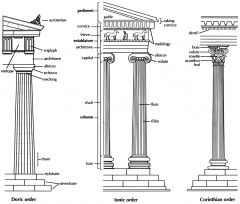![]()
![]()
![]()
Use LEFT and RIGHT arrow keys to navigate between flashcards;
Use UP and DOWN arrow keys to flip the card;
H to show hint;
A reads text to speech;
25 Cards in this Set
- Front
- Back
|
Rajaraja
|
947-1014
Indian conquered much, started Chola dynasty. Patron of arts. Hindu |
|
|
Chola
|
Kingdon
850-1250 refined Dravidian style stone temples, bronze sculptures Hindu |
|
|
Dravida style temples
gopurams stupi shikhara kalasha |
Pyramid shaped
sandstone and granite south GOPURAMS- gate pyramids STUPI- pointy top of tower SHIKHARA-tall tower KALASHA- ornaments the shikhara |
|
|
Rajput
|
literally, son of kings, collection of kingdoms
|
|
|
mewar
|
largest south rajput kingdom
|
|
|
Fort Palace
zenana mardana jarokha |
fort-palace: big palaces built on hill slopes, mix of fortification and palace
zenana-women's area of palace mardana-men's area. half state affairs, half for king's private area jarokha- projecting balconies |
|
|
company painting
|
british commisioned Indian painters, to show ethnographic/pseudo-scientific documentations
|
|
|
picturesque
|
photos/pictures showing pleasant subject matter. Idealizes british tastes. Like still pond with trees
|
|
|
style period
neo-classical indo-saracenic munemental classicicalism |
neoclassical-1172-1858
indo-saracenic- 1858-1931. indian mixed with venetian gothic style monumental classicisim- 1931-1947 |
|
|
1947
|
Indian independence from Britain. Now time for them to express themselves in own ways. Allowed for future post-modern works that explore their history
|
|
|
Portuguese Goa
|
Area that porteugese took, Goa. 1500-1960.
Added Christian art and religion. style? |
|
|
perceptual
conceptual |
perceptual- literally what you see
conceptual- ideas, visualizing, idealizing some kings chose to be shown perceptually, others conceptually |
|
|
chronologies:
Akbar: 10-11c moghuls: 1526-1958 meewari- 16-17c chola-10-11c susltanates: delhi-13c mahmani-15c bijapur-17c |
f
|
|
|
pietra dura
|
technique for ornament with stones in taj mahal and other places. Koranic inscriptions
|
|
|
Koran
|
lots of koranic tales and inscriptions in art and architecture, like taj mahal
|
|
|
Akbar
Jahangir Shan Jahan |
rulers
akbar-first mughal emperor janahgir-second shan jahan-third sons of songs art patrons |
|
|
char-bagh
|
persian 4-part garden with "+" that intersect garden's center. very geometrical
|
|
|
arabesque
|
flowy vine embellishments in art and architecture
islamic |
|
|
madrasa
|
Islamic learning centers
probably taught art |
|
|
sultanates
|
sultan rulers
had blending art styles, mix of hindu and islamic |
|
|
mosque:
-qibla -mihrab -minaret |
islamic
mihrab- semi-circle niche on mosque wall that indicates qibla qibla - the direction of macing Mecca minaret- tower at mosques with religious significance |
|
|
Krishna
Radha |
krishna- male god
Radha- his wife together, known for combining masculine and feminine aspects of gods |
|
|
column
architave pediment entablature |

|
|
|
Nehru
|
first indian prime minister.
leader of indian independence movement |
|
|
east-west opposition
|
clashing styles
west's materialism, east's spiritual qualities |

